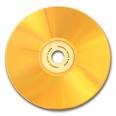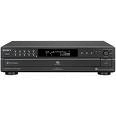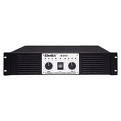|
Fidelity
...
a game of the weakest link!
|
|
|
Want to improve the sound of your audio system? Can it ever really be good enough? Being in the business of manufacturing audio gear I see the audiophile frenzy to upgrade components from a rather inside perspective. For some it is an never ending quest, for others it stops when the pocket book runs dry. The weakest link game is about spending as little money as possible while getting the highest fidelity you can. And it starts with the fundamental understanding that a chain is never stronger than it's weakest link. The audio chain is no different. You absolutely will NOT hear anything sound better than the poorest sounding component in your chain. The motivation for writing this paper comes from seeing people handicap their audio system on a daily basis. It's tragic to see someone purchase a great component and then handicap it with a weak link somewhere else in the chain so that they misjudge the new component. The weak link makes it hard to hear a justifiable improvement. A great amp might actually sound worse do to it's more detailed and revealing nature. THE CHAIN To the right are pictures of a typical audio chain. The chain starts with the recording or CD itself. This is one part where you have little control - other than the option of purchasing CD's that are well recorded. SOURCE The first real link in the chain that you do have complete control over is the source - in this example, the CD player. This is often the weakest link. Won't matter how good your cables and electronics are, they can only reproduce the signal your source gives them. If you are just putting together a system from scratch, spend the most money on the source. Then as time goes on you can gradually upgrade your amps and speakers, cables etc. With a good source you'll stand a better chance of hearing a justifiable difference between components. For example, you may have a $500 amplifier and have brought home a $1500 amplifier to compare with your own. Without a good source it is likely to sound perhaps 10% better than what you have making it hard to understand why it costs 3 times as much. With a good source you may perceive the difference to be huge and easily worth the upgrade. CONNECTIONS The second link in the chain to focus on is believe it or not, all of the electrical connections. This is THE most completely overlooked and underestimated link in the chain. Here is a great example: You yourself probably have a pair of interconnects that cost a little bit of money. Yet you handicap them with dirt and oils that actually shave the performance down to around 50% of what it could be. Take your interconnects out of your source and take a cotton Q-Tip with some 99% alcohol and insert it into the RCA jack. Twist it around a few times and pull it out. The Q-Tip will be black. You must have clean connections everywhere. Even clean and possibly sand the prongs on your AC power cords. Leave no stone un-turned. COMPONENTS This is where it gets tricky. Your preamp, amp, speakers, and each set of cables is considered a link. Which one is the weakest? Identifying the guilty one is largely a guessing game. If you are trying to decide between the preamp, amplifier or speakers you first need to set the stage to be able to recognize it when you hear it. To that end you should look closely at your cables. Both interconnects and speaker wires, even if they are not the weak link in your present system (not that you would know for sure) they need to be good so that when you do start auditioning different preamps or amplifiers you will be able to hear the most difference. Assuming that you have purchased a source that is clearly the most expensive component or have gotten lucky enough to find an affordable sleeper that sounds far better than it should... and you have purchased or at least tried better cables the next link is likely to be either the amp or preamp. Even a pair of boom box speakers glued into a cardboard box can give you enough information about all the electronics upstream to make some comparisons. Since you likely have better speakers than that, focus on your electronics for now. PREAMP The easiest way to determine if your preamp is a weak link is to listen for clarity. To do this we need to simply remove it and listen to the amplifier hooked directly to the source. IF the amp has no gain (volume) control and the source has no variable output, you will have to insert a passive volume control between your source and amplifier. With the preamp out of the chain listen for improved focus, detail and overall clarity. If putting the preamp back in the chain reduces any of these in any detectible way then your preamp is a weaker link then your amplifier. AMPLIFIERS Amplifiers come in a wide range of transparency and power. Switching out amplifiers is often the biggest change to your system as a whole that you can make at this stage. Amplifier's are typically the link in the chain with the most potential for cracks. For example, the amplifier may have lots of negative feedback (most do) and therefore limit the depth of a sound stage to just a few feet. It would be impossible to evaluate the differences between two CD players or DACs if you were trying to pick the one with the best depth and imaging. The amp would make the soundstage almost the same on both. This is by the way why it's wise to start this venture with the best source you can afford. Another example is how the amp relates to speakers. As a speaker designer who places great value on the speakers ability to disappear, I can recall many times when a given amplifier completely killed the disappearing act and you could hear sound coming directly from the speakers. I hate that. But think about it - suppose the guy who owns the amp at fault buys a pair of my speakers because he's looking for a more holographic 3D soundstage... you can see where I might be going with that. The only way to tell if or how bad your amplifier is handicapping your system is to try different ones and compare. In my own systems I make the amplifier the strongest link in the chain by a factor of about four. That way I can focus on all the remaining links for the duration. I already know that regardless of what a person spends on a source, vinyl or CD, it is not going to sound as good as the original master tape played off the mastering deck. Because of that I know that there will never be enough money in this lifetime to have a perfect source and the source will always be a weaker link than my amplifier. Once I have the amp in place I can play with different sources, cables and speakers forever and always be in a position to hear the differences they bring. SPEAKERS The better a speaker is the worse it is capable of sounding. Speakers can be compared to telescopes in the sense that a given speaker will magnify the signal by a certain amount. Do you want to look at the moon or see the craters on it? There is a big difference in speakers. The mainstream speakers are designed with complex crossovers with higher power amplifiers in mind. What makes a great sounding one is it's ability to mask without being obvious about it. True high fidelity speakers tend to also be high efficiency speakers. (There are probably more high efficiency speakers with questionable fidelity than without, but that usually lies in the execution.) Assuming you have a good high efficiency speaker it's like going to high higher power lenses on the telescope. This higher level of detail makes hearing differences in components all that much easier. Often what happens to first time owners of high efficiency speakers is a rude awakening that reveals weaknesses in other components. Weaknesses that the lower resolution speakers did not let you hear. Because high efficiency speakers are ultimately required to hit the top of the fidelity ladder it becomes practical to have the amp and source quality to back it up. The quality I'm talking about is the kind you have to hunt for. This is why it works to leave the speakers for last. I have a favorite, my HDT speaker that is so honest and so quick that your gear or the recording must be on it's game or the speakers can sound simply horrible. In the same moment you can hit the stop button, put in a well recorded disk and suddenly the speakers sound so right you get goose bumps! Anyway, this is the basic audio chain - on the surface. It can be broken down into smaller but longer chains within each piece of electronics. This is commonly referred to as the internal signal path. How many links are in the internal chain of a particular amplifier or preamplifier... well on the one extreme end like our Zen amp, there are 4 components in the signal path; 1 capacitor and 2 resistors and a transformer. Each of these components in the signal path can have as great an effect as any of the other links we've talked about in this paper. Now on the other extreme end, say a solid state AV receiver, the signal path may have as many as 50 or more links. A chain with 50 links has a larger chance of one or more weak ones when compared to a chain with only 4. Deeper still are the connecting nodes between each link in the amplifier, such as the solder and wire. Then there are the supporting elements which also become links, such as the power supply, sockets, connectors, tubes, IC's and so on. Below that are the layout, magnetic fields of each part and wire, the chassis and eddy currents. Our sample pictures on the top right of the basic audio chain represent 8 links, but if you break it down to the internal links of each component the audio system has between 100 and 1000 links in the chain. Since the game of it all is in guessing what link is actually the weakest, having less links increases your odds. And when does it end? Most people who chase fidelity perceive the ladder as the ladder of accumulation. The more it costs and the more of it you have the better your odds. The irony is that it's more like a pyramid. The higher you get to the top the less stones there are. The ideal chain would consist of a single gain stage connected to a single voice coil (per channel) targeted at a single listener.
-Steve Deckert
|
|
|
|
|
|
|
|
|
Decware is a trademark of High Fidelity Engineering
Co.
|
|







